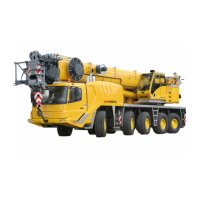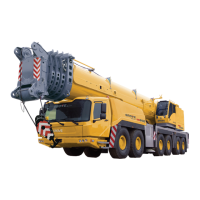Grove Published 7-23-2020, Control # 668-02 4-17
GRT9165 OPERATOR MANUAL OPERATING PROCEDURES
• Hook block must be removed from main boom nose.
• Overhaul ball may be reeved over boom extension,
hanging 0.9 m (3 ft) below sheave.
Extended Traveling
For extended travel with counterweight removed, the
following applies:
• Boom must be at 0° and centered over front single axle,
no distance limit with a maximum speed of 4 kph
(2.5 mph).
• Boom must be at 0° and centered over rear tandem
axles, no distance limit with a maximum speed of 24 kph
(15 mph).
For extended travel with both counterweight and outrigger
boxes removed, the following applies:
• Boom must be centered over front single axle, no
distance limit with a maximum speed of 4 kph (2.5 mph).
• Boom must be centered over rear tandem axle, no
distance limit.
Traveling — Forward
NOTE: Cab must be in the fully lowered position for the
drive functions to operate. If cab is not in the fully
lowered position, the Cab Not Fully Lowered
Indicator in the Alerts Area (1, Figure 4-74) of the
Operator Display Module (ODM) is on.
NOTE: The standard driving configuration for the
GRT9165 is with the boom centered over the single
front axle. The crane can also be driven with the
boom centered over the dual rear axles. Before
driving with the boom over the rear of the crane,
operator must press the Steering Reversal Switch
to reverse the driving controls, including the
transmission shift lever control. Thus, the direction
the boom is pointing, and the operator is facing, is
always considered forward.
For the description and location of the Steering
Reversal Switch, refer to Steering Reversal Switch,
page 3-14.
1. With Transmission Shift Lever in neutral (N) position and
the parking brake set, start engine and allow it to
adequately warm up.
2. Press Service Brake Foot Pedal.
3. Disengage parking brake.
4. Position Drive Axle Switch to two-wheel high or
four-wheel low.
5. Lift Transmission Shift Lever up out of detent and push
lever to the forward (F) position. Rotate the
Transmission Shift Lever Knob to the first (1) gear
position. Gear selection “F1” appears in the Operator
Display Module (ODM) to indicate forward propulsion
and first (1) gear are selected.
NOTE: If Service Brake Foot Pedal is not pressed before
shifting to a gear, the gear selection will flash in the
Operator Display Module (ODM) until the
Transmission Shift Lever is returned to the neutral
(N) position. Transmission will not shift.
6. Release Service Brake Foot Pedal and press Foot
Throttle Pedal until maximum first gear speed is
reached. Rotate Transmission Shift Lever Knob to the
CAUTION
Tire Damage Hazard!
For extended travel, check cold tire pressure before start.
(Refer to tire inflation chart in Load Chart Manual.) After
driving the following distances, regardless of ambient
temperature, stop and allow tires to cool for at least 30
minutes:
• 4 km (2.5 mi) at a maximum speed of 16 kph
(10 mph) with counterweight installed and boom over
front single axle
• 75 m (250 ft) at a maximum speed of 4 kph (2.5 mph)
with counterweight installed and boom over rear
tandem axles
At destination, tires must be allowed to cool to ambient
temperature before crane lifting on rubber.
CAUTION
Machine Damage Hazard!
Engage turntable lock pin for travel. Failure to engage
lock pin may allow superstructure to swing uncontrolled,
damaging machine and/or property.
WARNING
Run-away Crane Hazard!
Releasing the parking brake while the low service brake
pressure indicator is on and the buzzer is sounding,
indicating service brakes are inoperable, may result in the
crane rolling away freely without the ability of operator to
stop crane.
Never release parking brake while low service brake
pressure indicator and buzzer are on.
CAUTION
Use four-wheel drive only when more traction is required.

